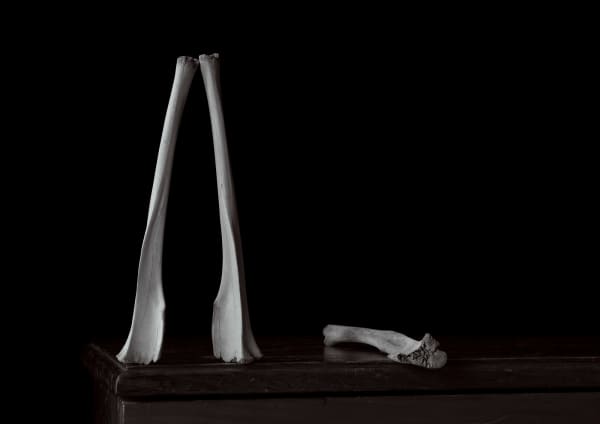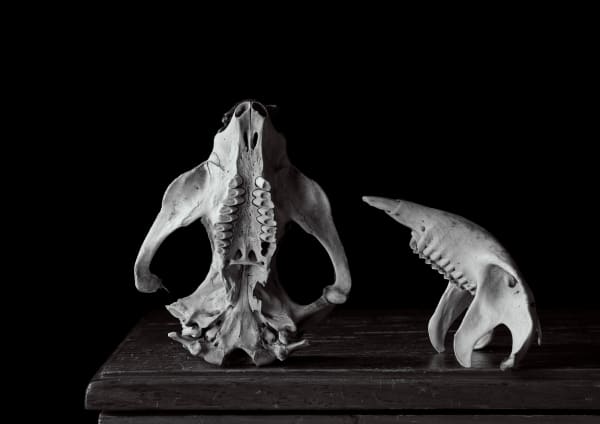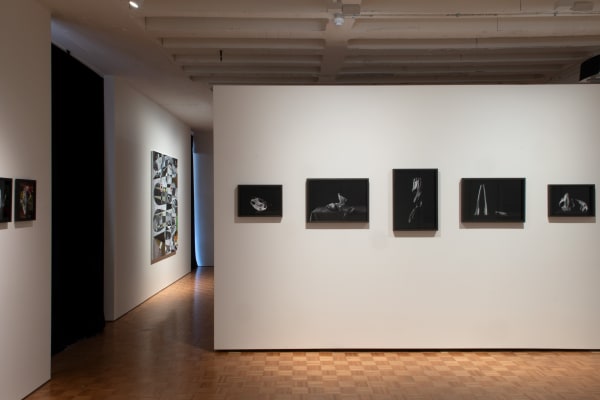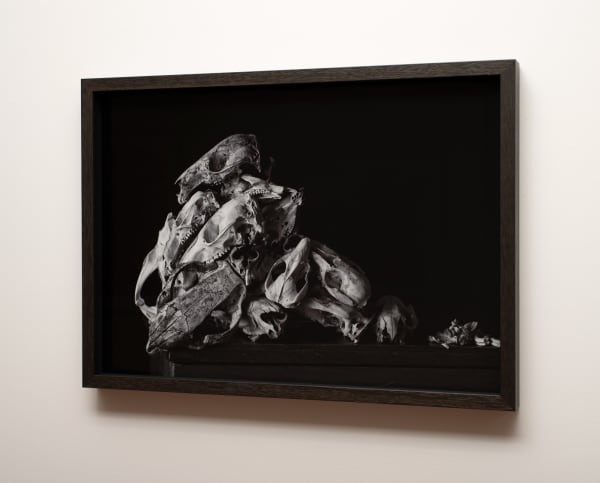David Stephenson: bone country
Is the Anthropocene the epoch of ecocide? In post-colonial lutruwita/Tasmania, land clearing, overgrazing, forestry, and hydro-industrialisation have drastically shrunk the verdant forests that once covered the island. The corpses of drowned trees rise out of hydro impoundments or stand solitary in drought-stricken paddocks. A fifty-meter thin green veneer of bush screens the highway traveller from the clear-felled realities of industrial forestry, where slash piles await the carbon emitting regenerative burns inflicted to replace ancient native forests with monoculture plantations. Council workers patrol the roads daily to remove from tourists' view the shameful carnage of roadkill. Black crows pick clean the remaining carcasses, deftly hopping aside for passing traffic, and the ditches are littered with the skeletons of once living and breathing wombats and wallabies.
Still, the prevalence of roadkill attests to the relative abundance of wildlife in Tasmania, and the habitat that supports it; in many parts of Australia, one sees no roadkill, because there is little native habitat left to sustain the native fauna. In Tasmania, trees and animals persist despite these bruising encounters with the human species, and the crystalline Tasmanian light reveals what remains despite our mistakes.
In a career spanning four decades, David Stephenson has produced some of the most powerful photographic images in contemporary art. Stephenson’s ability to capture the vast and terrifying beauty of both our natural and industrial landscapes is unrivalled; rendering his exploration of the cosmological and technological sublime, truly awe-inspiring. From the domes and cupolas of humankind’s greatest architectural achievements, to the infinite stars in the vaulted night sky, Stephenson’s images are humbling and exultant — each a monument to majesty.
A meditation on the sublime has guided Stephenson’s artistic practice, which has evolved through long-term, interrelated projects of inquiry. His photographic typologies of the transcendent ceilings of European sacred architecture have been published in two monographs with Princeton Architectural Press, with German editions by Prestel Verlag – Visions of Heaven: The Dome in European Architecture (2005) and Heavenly Vaults: From Romanesque to Gothic in European Architecture (2009).
While travelling for these architectural projects Stephenson made his first photographs of cities at night, bringing together a number of his previous interests, including the idea of the sublime, environmental concerns, and the transcendental power of light. The glowing “light city” seems the perfect emblem of so much that is both good and bad in our industrialized culture: an extraordinary example of a monumental technological sublime, where awe, beauty, and human aspiration are tinged with the horror of potential environmental catastrophe, our engine of modernity seemingly running on empty.
A focus of Stephenson's work from 2010 to 2017 was his collaboration with Martin Walch on the Derwent Project, funded by an Australian Research Council Discovery Grant to develop new digital approaches to the representation of complex and remote environments. A major exhibition of this project was presented at the Tasmanian Museum and Art Gallery in July-November 2017. In 2014 Stephenson also began independently creating time-lapse images and videos drawn from both urban and natural environments. These have been computationally composited to create Time Slice still images and videos.
After working mostly with digital photography over the past ten years, in 2019 Stephenson went back to the folding wooden field camera and 5" x 7" black and white sheet film used in his earliest work. Survivors continues his long-term exploration of that quintessential Australian tree genus, Eucalyptus. We are only recently learning some of the many secrets of the arboreal world, with its complex networks and hidden ecosystems. These tree portraits are memorials to survivors and victims of bruising encounters with the human species. Whether dead or clinging to life amidst the onslaughts of fire, drought, over-grazing, logging and hydroelectric drowning, the trees offer testimony to perseverance and endurance over long lives.
Stephenson’s photographs and video have been exhibited extensively internationally, including solo exhibitions at the Art Gallery of New South Wales (1993 and 2017), the Australian Centre for Contemporary Art (1994), the Paisley Museum and Art Gallery, Scotland (1995), the National Gallery of Victoria, (1998), the Cleveland Museum of Art (2001), and the Tasmanian Museum and Art Gallery (2001 and 2017). His work is represented in many public and private collections including the Art Gallery of New South Wales, the Art Gallery of South Australia, the Bibliotheque Nationale in Paris, the National Gallery of Australia, the National Gallery of Victoria, the Queensland Art Gallery, the Tasmanian Museum and Art Gallery, the International Museum of Photography and Film at George Eastman House, the San Francisco Museum of Modern Art, and the Museum of Modern Art and Metropolitan Museum of Art in New York.
-
 David StephensonLyell Hwy near Gretna 1, 2023pigment ink print
David StephensonLyell Hwy near Gretna 1, 2023pigment ink print
edition of 5 plus 1 AP
available two sizes:
76.2 x 101.6 cm - $5,000 + framing
101.6 x 132.1 cm - $7,000 + framing -
 David StephensonLyell Hwy near Gretna 2, 2023pigment ink print
David StephensonLyell Hwy near Gretna 2, 2023pigment ink print
edition of 5 plus 1 AP
available two sizes:
76.2 x 101.6 cm - $5,000 + framing
101.6 x 132.1 cm - $7,000 + framing -
 David StephensonArthurs Lake 1, 2024pigment ink print
David StephensonArthurs Lake 1, 2024pigment ink print
edition of 5 plus 1 AP
available two sizes:
76.2 x 101.6 cm - $5,000 + framing
101.6 x 132.1 cm - $7,000 + framing -
 David StephensonArthurs Lake 2, 2024pigment ink print
David StephensonArthurs Lake 2, 2024pigment ink print
edition of 5 plus 1 AP
available two sizes:
76.2 x 101.6 cm - $5,000 + framing
101.6 x 132.1 cm - $7,000 + framing -
 David StephensonBarren Plains Rd 1, 2023pigment ink print
David StephensonBarren Plains Rd 1, 2023pigment ink print
edition of 5 plus 1 AP
available 2 sizes:
101.6 x 76.2 cm - $5,000 + framing
132.1 x 101.6 x cm - $7,000 + framing -
 David StephensonBarren Plains Rd 2, 2024pigment ink print
David StephensonBarren Plains Rd 2, 2024pigment ink print
edition of 5 plus 1 AP
available two sizes:
76.2 x 101.6 cm - $5,000 + framing
101.6 x 132.1 cm - $7,000 + framing -
 David StephensonNear Gretna, 2022pigment ink print
David StephensonNear Gretna, 2022pigment ink print
edition of 5 plus 1 AP
available two sizes:
76.2 x 101.6 cm - $5,000 + framing
101.6 x 132.1 cm - $7,000 + framing -
 David StephensonLyell Hwy near Bronte Lagoon 1, 2021pigment ink print29.7 x 21 cmedition of 5 plus 1 artist's proofAU$ 1,000.00 + FRAMING
David StephensonLyell Hwy near Bronte Lagoon 1, 2021pigment ink print29.7 x 21 cmedition of 5 plus 1 artist's proofAU$ 1,000.00 + FRAMING -
 David StephensonLyell Hwy near Bronte Lagoon 2, 2021pigment ink print29.7 x 21 cmedition of 5 plus 1 artist's proofAU$ 1,000.00 + FRAMING
David StephensonLyell Hwy near Bronte Lagoon 2, 2021pigment ink print29.7 x 21 cmedition of 5 plus 1 artist's proofAU$ 1,000.00 + FRAMING -
 David StephensonLyell Hwy near Bronte Lagoon 3, 2021pigment ink print29.7 x 21 cmedition of 5 plus 1 artist's proofAU$ 1,000.00 + FRAMING
David StephensonLyell Hwy near Bronte Lagoon 3, 2021pigment ink print29.7 x 21 cmedition of 5 plus 1 artist's proofAU$ 1,000.00 + FRAMING -
 David StephensonLyell Hwy near Bronte Lagoon 4, 2021pigment ink print29.7 x 21 cmedition of 5 plus 1 artist's proofAU$ 1,000.00 + FRAMING
David StephensonLyell Hwy near Bronte Lagoon 4, 2021pigment ink print29.7 x 21 cmedition of 5 plus 1 artist's proofAU$ 1,000.00 + FRAMING -
 David StephensonLyell Hwy near Bronte Lagoon 5, 2021pigment ink print29.7 x 21 cmedition of 5 plus 1 artist's proofAU$ 1,000.00 + FRAMING
David StephensonLyell Hwy near Bronte Lagoon 5, 2021pigment ink print29.7 x 21 cmedition of 5 plus 1 artist's proofAU$ 1,000.00 + FRAMING -
 David StephensonLyell Hwy near Bronte Lagoon 6, 2021pigment ink print29.7 x 21 cmedition of 5 plus 1 artist's proofAU$ 1,000.00 + FRAMING
David StephensonLyell Hwy near Bronte Lagoon 6, 2021pigment ink print29.7 x 21 cmedition of 5 plus 1 artist's proofAU$ 1,000.00 + FRAMING -
 David StephensonLyell Hwy near Bronte Lagoon 7, 2021pigment ink print29.7 x 21 cmedition of 5 plus 1 artist's proofAU$ 1,000.00 + FRAMING
David StephensonLyell Hwy near Bronte Lagoon 7, 2021pigment ink print29.7 x 21 cmedition of 5 plus 1 artist's proofAU$ 1,000.00 + FRAMING -
 David StephensonLyell Hwy near Bronte Lagoon 8, 2021pigment ink print29.7 x 21 cmedition of 5 plus 1 artist's proofAU$ 1,000.00 + FRAMING
David StephensonLyell Hwy near Bronte Lagoon 8, 2021pigment ink print29.7 x 21 cmedition of 5 plus 1 artist's proofAU$ 1,000.00 + FRAMING -
 David StephensonLyell Hwy near Bronte Lagoon 9, 2021pigment ink print29.7 x 21 cmedition of 5 plus 1 artist's proofAU$ 1,000.00 + FRAMING
David StephensonLyell Hwy near Bronte Lagoon 9, 2021pigment ink print29.7 x 21 cmedition of 5 plus 1 artist's proofAU$ 1,000.00 + FRAMING -
 David StephensonLyell Hwy near Bronte Lagoon 10, 2021pigment ink print29.7 x 21 cmedition of 5 plus 1 artist's proofAU$ 1,000.00 + FRAMING
David StephensonLyell Hwy near Bronte Lagoon 10, 2021pigment ink print29.7 x 21 cmedition of 5 plus 1 artist's proofAU$ 1,000.00 + FRAMING -
 David StephensonLyell Hwy near Bronte Lagoon 11, 2021pigment ink print29.7 x 21 cmedition of 5 plus 1 artist's proofAU$ 1,000.00 + FRAMING
David StephensonLyell Hwy near Bronte Lagoon 11, 2021pigment ink print29.7 x 21 cmedition of 5 plus 1 artist's proofAU$ 1,000.00 + FRAMING -
 David StephensonLyell Hwy near Bronte Lagoon 12, 2021pigment ink print29.7 x 21 cmedition of 5 plus 1 artist's proofAU$ 1,000.00 + FRAMING
David StephensonLyell Hwy near Bronte Lagoon 12, 2021pigment ink print29.7 x 21 cmedition of 5 plus 1 artist's proofAU$ 1,000.00 + FRAMING -
 David StephensonLyell Hwy near Bronte Lagoon 13, 2021pigment ink print21 x 29.7cmedition of 5 plus 1 artist's proofAU$ 1,000.00 + FRAMING
David StephensonLyell Hwy near Bronte Lagoon 13, 2021pigment ink print21 x 29.7cmedition of 5 plus 1 artist's proofAU$ 1,000.00 + FRAMING -
 David StephensonHighland Lakes Rd 1, 2022pigment ink print29.7 x 42 cmedition of 5 plus 1 artist's proofAU$ 2,000.00 + FRAMING
David StephensonHighland Lakes Rd 1, 2022pigment ink print29.7 x 42 cmedition of 5 plus 1 artist's proofAU$ 2,000.00 + FRAMING -
 David StephensonLyell Hwy near Derwent Bridge, 2022pigment ink print42 x 59.4 cmedition of 5 plus 1 artist's proofAU$ 3,000.00 + FRAMING
David StephensonLyell Hwy near Derwent Bridge, 2022pigment ink print42 x 59.4 cmedition of 5 plus 1 artist's proofAU$ 3,000.00 + FRAMING -
 David StephensonLake St Clair 2, 2023pigment ink print59.4 x 42 cmedition of 5 plus 1 artist's proofAU$ 3,000.00 + FRAMING
David StephensonLake St Clair 2, 2023pigment ink print59.4 x 42 cmedition of 5 plus 1 artist's proofAU$ 3,000.00 + FRAMING -
 David StephensonBronte Lagoon, 2022pigment ink print42 x 59.4 cmedition of 5 plus 1 artist's proofAU$ 3,000.00 + FRAMING
David StephensonBronte Lagoon, 2022pigment ink print42 x 59.4 cmedition of 5 plus 1 artist's proofAU$ 3,000.00 + FRAMING -
 David StephensonHighland Lakes Rd 2, 2022pigment ink print29.7 x 42 cmedition of 5 plus 1 artist's proofAU$ 2,000.00 + FRAMING
David StephensonHighland Lakes Rd 2, 2022pigment ink print29.7 x 42 cmedition of 5 plus 1 artist's proofAU$ 2,000.00 + FRAMING -
 David Stephenson400m of Lyell Highway near 14 Mile Rd, 22 June 2022pigment ink print42 x 59.4 cmedition of 5 plus 1 artist's proofAU$ 3,000.00 + FRAMING
David Stephenson400m of Lyell Highway near 14 Mile Rd, 22 June 2022pigment ink print42 x 59.4 cmedition of 5 plus 1 artist's proofAU$ 3,000.00 + FRAMING -
 David Stephenson800m of Lyell Hwy near Bronte Park 20 January 2022pigment ink print42 x 59.4 cmedition of 5 plus 1 artist's proofAU$ 3,000.00 + FRAMING
David Stephenson800m of Lyell Hwy near Bronte Park 20 January 2022pigment ink print42 x 59.4 cmedition of 5 plus 1 artist's proofAU$ 3,000.00 + FRAMING -
 David Stephenson500m of Lyell Hwy near Bronte Lagoon 21 October 2021pigment ink print42 x 59.4 cmedition of 5 plus 1 artist's proofAU$ 3,000.00 + FRAMING
David Stephenson500m of Lyell Hwy near Bronte Lagoon 21 October 2021pigment ink print42 x 59.4 cmedition of 5 plus 1 artist's proofAU$ 3,000.00 + FRAMING -
 David StephensonRussell River, 2022pigment ink print21 x 29.7 cmedition of 5 plus 1 artist's proofAU$ 1,000.00 + FRAMING
David StephensonRussell River, 2022pigment ink print21 x 29.7 cmedition of 5 plus 1 artist's proofAU$ 1,000.00 + FRAMING











































